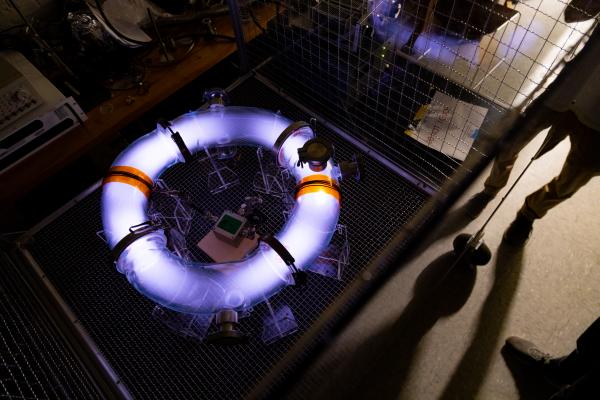
Altator's first plasma
April 5, 2024
For the first time since 2016, a toroidal device housed at the PSFC has produced plasma, and it’s thanks to the work of ten graduate students. Named Altator in homage to the experimental tokamak that operated at the PSFC from 1994 to 2016, the students’ device is a miniature version that will be used to show visitors how plasma flows and is confined within the donut-shaped architecture of a tokamak’s design. Unlike its full-sized sibling, Altator’s plasma vessel is completely transparent, allowing viewers a safe look at the beautiful lavender glow the device produces.
Altator has been a labor of love for Nuclear Science and Engineering PhD students John Ball, Jacob van de Lindt, Grant Rutherford, Audrey Saltzman, Thomas Varnish, Alex Velberg, and Physics PhD students Miguel Calvo-Carrera, Tucker Evans, Shon Mackie, and Scott Moroch.
Third-year student Audrey Saltzman remembers the study group out of which the project was born: “We started thinking about how we really wanted hands-on experience.” Grant Rutherford, another third year student, recalls, “We tried to think of what kind of device would be good for students to learn on and we came up with Altator. I see it operating like a mini tokamak. We’ll have a run campaign, and students will propose experiments.”
The group put together a proposal and pitched the idea to the PSFC’s then-director, Dennis Whyte, who provided seed funding and the freedom to figure it out for themselves; they’d design, source components, and build the device on their own. "Altator is a testament to two great features of our graduate students at PSFC. First they want to get to do hands-on activities that incorporate technology, science, project management and team-building. Second, it shows their passion for education and outreach, making plasma and fusion science more accessible," said Whyte.
The group has spent the last two years bringing Altator to life in their free time. In addition to gaining practical skills, the students’ goal was to create a demo that was robust, accurate, affordable, re-creatable, and most of all, really cool– though the journey wasn’t without its hiccups.
Rutherford admitted, “The making of Altator was far more challenging than I think we had realized. [...] The actual fabrication was really challenging.”
It’s been a labor of love. In addition to being full-time students with work and study obligations, the group had to handle procurement of the parts and the engineering of new, bespoke components. The glass torus used in the device to contain the plasma isn’t something they could simply buy online; it had to be hand blown by Precision Glass Blowing, and made to the group’s exact specifications.
In plasma devices big and small, specialized radio frequency (RF) antennas are used to create plasmas by driving a current through the gas, which strips off the gas’s electrons and transitions it into plasma. The RF antenna was key to Altator actually producing plasma, and the group spent months experimenting to create what they hoped was an effective design. After the antenna’s installation, they expected that it would take several tries and additional tinkering to produce the tell-tale glow inside their torus. Instead, “Making the plasma was so easy. We just turned it on and it worked,” said Rutherford.
Saltzman added, “I think everyone was honestly pretty shocked; we had a lot of questions about whether we’d get a plasma around the whole device–and we do. Recent work people have been doing has shown we only need one antenna to get all the way around the device, which is not what we expected.”
Thus, after an eight year hiatus, a plasma-producing device returned to MIT, and it will likely be the only device in Cambridge for a while. The PSFC is currently collaborating with MIT spin-off Commonwealth Fusion Systems to develop SPARC, a magnetic confinement fusion tokamak that is predicted to produce more energy than it consumes, but that device will be located in Devens, MA.
As for Altator, first plasma is certainly an important milestone, but there’s farther to go. The group is currently recruiting new students to help design and fabricate the Bitter plate magnets that will ring Altator’s torus and show how magnetic fields can influence plasma. Someday Altator will also sport more modern and powerful REBCO magnets that will allow viewers to compare the technologies used in the tokamaks of yore and cutting-edge devices like SPARC.
For now, Altator is being integrated into tours of the PSFC’s lab so visitors can see for themselves the bright future of plasma fusion.
To stay up to date on the project’s progress, follow @mit_altator on social media.
Topics: Plasma science, SPARC, Plasma-based technologies